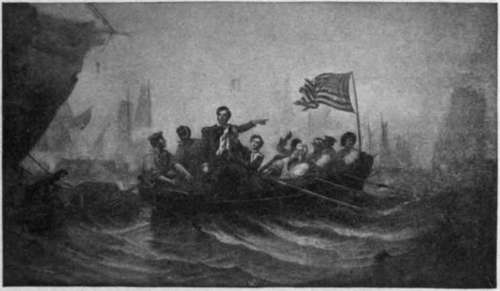Battle Of Lake Erie
Description
This section is from the book "The National Capitol. Its Architecture Art And History", by George C. Hazelton, Jr. Also available from Amazon: The National Capitol Its Architecture Art and History.
Battle Of Lake Erie
On the wall above the landing of the staircase is the celebrated picture by W. H. Powell, known as the Battle of Lake Erie, fought at Put-In Bay on the ioth of September, 1813, during our second war with Great Britain. It represents Oliver Hazard Perry in the midst of the battle as he leaves the disabled flag-ship Lawrence, in the foreground, to transfer his battle-flag to the Niagara, upon the right, in order to renew the fight. Through lack of wind, the Lawrence had been compelled alone to engage almost the entire British fleet, especially the Detroit and Queen Charlotte, and had quickly become disabled under the tremendous fire to which she was exposed. As a daring resort, Perry hauled down his Union Jack, having for its motto the dying words of the beloved Lawrence, " Don't give up the ship," and taking it over his arm, ordered a boat made ready. The English Commodore, anticipating a surrender, signalled his men to cease firing. But when he saw Perry emerging from the smoke, standing boldly erect among his oarsmen and heading fearlessly for the Niagara, Barclay divined his object and ordered the fire of the fleet to be centered upon the little craft. Perry miraculously made the passage in safety—occupying a period of some minutes—in the very teeth of the broadsides and small arms turned upon him, hoisted his flag at the masthead of the Niagara, renewed the fight, and captured the English fleet. This is the only instance in her history when England lost an entire fleet, and it surrendered to a man of twenty-seven. It was on this occasion that Perry sent the celebrated dispatch to the general in command of the American Army of the Northwest, William Henry Harrison :
U. S. Brig Niagara, September ioth, 1813 ; 4 p.m.
Dear General:—
We have met the enemy and they are ours : two Ships, two Brigs, one Schooner and one Sloop. Yours, with great respect and esteem,
O. H. Perry.
Powell, in painting the picture, selected for some of his models men employed in various capacities about the Capitol. The face of the sailor with his head bound and blood streaming from it is that of Captain John Decker, for many years " boss rigger " of the building. The chief interest in the picture arises from its dramatic qualities. As a marine painting it is not great. The perspective of the ships in the background is unmistakably bad. The whole picture gives the effect of a toy battle. The men in the boat, instead of being begrimed with smoke and oil and powder, are fresh as if on dress parade. The coloring, too, is unnatural. Yet, in spite of many technical incongruities and undoubted weakness in artistic expression, the picture has a charm which holds the attention as fixed as any which hangs upon the walls of the Capitol. This charm lies in the romance which encircles Perry's name as the " Hero of Lake Erie," and in the sympathy awakened by the tender bit of pathos admirably portrayed by the artist in the boy-brother* tugging at the Commodore's sleeve. There is one bit of painting in the picture of the highest order of excellence : it is the flag which floats from the small boat. That flag really feels the battle breeze. The sum of $25,000 was appropriated by Congress for the work.

BATTLE OK LAKE ERIE.
Continue to:
